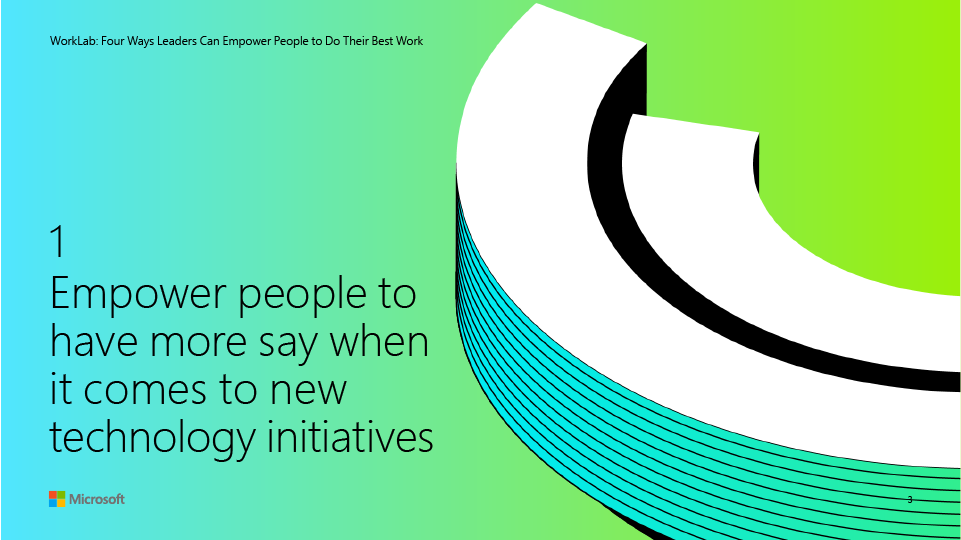
Fraying supply chains. Economic headwinds. Changing expectations around hybrid work. The rapid transformations of the past few years have fundamentally reshaped work and life as we know them. It’s clear that the agility and resilience of every organization rest on a workforce empowered with tools that enable them to work more efficiently and flexibly than ever before.
Download

For True Digital Transformation, Prioritize Collaboration—and Autonomy
That shift isn’t about overburdening your teams or deprioritizing innovation. It’s about being more effective, enabling people to do their best work with processes and tools that reduce friction, unlock innovation and creativity, and reduce busywork to help every individual focus on the work that matters most.
To take stock of how people feel about the digital productivity tools they use today and those they need to succeed in the future, Microsoft surveyed 2,700 employees and 1,800 business decision makers (BDMs) in the United States, the United Kingdom, and Japan. We asked questions like, Do people feel empowered by the tools they currently have? Are teams equipped to collaborate effectively in a world of flexible work? Can new technology like AI and low-code and no-code tools help solve their challenges and open up new opportunities?
9 out of 10 people want simpler ways to automate daily tasks so they can focus on the work that matters.
The survey spanned a range of job functions and industries—from marketing, sales, and customer service to finance, supply chain, and IT. This group included hybrid employees: about two-thirds of those surveyed either work from home or only part time in the office. The results offer a window into how technology is helping—and hindering—people today, along with fresh insights into the tools and processes leaders should adopt to help people be more energized, empowered, and productive.
The survey findings point to four key principles that can guide business leaders in 2023:
Empower people to have more say when it comes to new technology initiatives
Use collaborative apps to stay connected and share information in the flow of work
Accelerate innovation by equipping anyone in the organization with low-code tools
Help people feel more fulfilled and engaged by implementing AI and automating busywork
1. Empower people to have more say when it comes to new technology initiatives
Today’s employees are hungry for better digital tools. 87% of employees believe pursuing digital transformation is more important now than ever before, but only half of them (54%) say they are among the decision makers when it comes to those efforts. (For BDMs that figure is 94%.) Respondents say their teams would benefit most from solutions that help them be more agile (84%), make information more accessible across the organization (86%), and allow them to automate tasks (86%)—freeing time to focus on work that matters.
At present, however, outdated technology—including different departments within an organization using different software—is creating silos that make it challenging for people to share information related to digital transformation goals (72%), and existing tools generate more administrative tasks and busywork (74%).
Employee Empowerment
Stakeholders across the organization want employees to have a say in digital transformation initiatives.
Chart showing that 84% of business decision makers and 79% of employees think it’s important to receive employee buy-in to guide a digital transformation to success.
These shortcomings point to a gap between what leadership and technology departments consider to be priority investments in business software and tools, and the actual needs of a workforce often dispersed across locations. While 84% of surveyed business decision makers say digital transformation projects remain a top priority, 61% of employees say they are not an integral part of that process. And 70% say that organizational policies limit their ability to proactively explore or implement digital solutions on their own.
“The saying is that technology is easy and people are hard,” says Nicole Forsgren, a partner at Microsoft Research. People, essentially, are the most important part of an organization, but they’re also the most complex. “If you remove all agency from people, if they can’t contribute, if they can’t make any decisions, it can be really discouraging.”
The result is a disconnect: whatever investments in digital solutions the organization is making, many individuals don’t have much say in the matter. People overwhelmingly want initiatives to shift from being led by the IT department to being led by people across the organization, with 85% of respondents agreeing that people across all departments need to be involved—not just IT or senior leadership.
“If you remove all agency from people, if they can’t contribute, if they can’t make any decisions, it can be really discouraging.”
For leaders, having a system and process in place through which teams can push for new tools is key. Of one company that does this, Forsgren says, “They have an internal support structure with separate tiers—gold, silver, and so on—where workers can advocate for an expansion of tools, and also retirement of tools.”
Take action:
Get people involved with digital business investments: create a continuous feedback loop to inspire excellence.
Accelerate adoption of low-code tools to fuel innovation and help employees gain new skills.
2. Use collaborative apps to stay connected and share information in the flow of work
Flexible work is here to stay. Two-thirds (66%) of surveyed employees have the option to work either at a company location or remotely, with nearly all (91%) of those respondents working remotely at least one or two days a week.
As organizations navigate this new world of work, 85% of employees cited collaboration tools as one of the most necessary parts of their company’s digital transformation efforts. “Collaboration is a mindset,” says Emily He, corporate vice president of business applications at Microsoft. “People want to be able to collaborate with their colleagues and partners right then and there, whether they’re working on a customer situation or trying to resolve a supply chain issue. Collaboration capabilities need to be infused and embedded in everything we do.”
Integration Is Essential
Instead of fragmented tools that don’t integrate with day-to-day job functions, people want a single, integrated platform.
Chart showing that 64% of employees agree the lack of integration between their organizations’ tools and processes makes it difficult to collaborate across teams.
At the same time, 59% of employees feel that the tools they use to collaborate do not align with how their teams prefer to work. The tools don’t integrate with day-to-day processes, which makes it difficult to collaborate across teams, according to 64% of employees, and nearly three out of four (72%) wish the tools they use to collaborate were compatible with one another, instead of being highly fragmented. At least 7 in 10 cite inaccurate data, the inability to access and share decentralized data, and teams working from different sets of data as key challenges their companies need to address.
“The future is going to be all about turning your ideas into something people can touch and use.”
Compounding the problem, says Maribel Lopez, founder and principal analyst at Lopez Research, is the current hybrid nature of work itself. Collaboration tools, she notes, need to function seamlessly, whether an employee is at home or in the office or somewhere in between. And many people are not sitting at a desk in front of a computer. “If you’re in retail, people are roaming the floor serving customers,” she says. “The technology they carry has to allow them to share and access information in real time.”
Asked what would work best for them, nearly 9 in 10 respondents (86%) pointed to the same solution: a single, centralized platform or portal where teams can collaborate in multiple ways.
This solution would not only break down silos between people but also make it easier to access, share, and work together on data across the organization. This is especially crucial given the challenges organizations expect to face over the next year.
Take action:
Consider an audit of your organization’s current collaboration tools to identify gaps and areas for improvement.
Together with employees, develop KPIs for the ideal collaboration tool—a list of mandatories that reflect both employee and company needs.
Centralize and organize resources so that people are using consistent, current data for better efficiencies and integration.
Embed collaboration capabilities in the flow of work so people can work with colleagues, partners, and customers to efficiently solve problems and access contextual information from other systems.
3. Accelerate innovation by equipping anyone in the organization with low-code tools
With IT projects backlogged, underfunded, or always “just over the horizon,” no-code and low-code tools have taken center stage, allowing people to automate processes or even create their own apps with little or no coding, clear a path for innovation, and offer solutions to the other frustrations voiced in the survey.
Clothing giant H&M was recently able to use these tools to empower thousands of employees , from clothing designers to software engineers, to build the solutions they needed. “The future is going to be all about turning your ideas into something people can touch and use,” He says. “Typically, workers are on the receiving end of digital transformation. But we’ve entered a new phase, where they are taking matters into their own hands and using low-code and no-code tools to create new apps and experiment with new ways of engaging with customers, managing processes, or accessing business insights.”
Level Up with Low Code
Low-code tools have empowered people to be self-sufficient on tasks that previously would have required a team of developers.
Chart showing that more than 3 out of 4 respondents (77%) wish that they had more access to low-code/no-code tools or platforms to build digital solutions that help them achieve their goals.
Even so, more than 3 out of 4 respondents (77%) wish they had more access to low-code or no-code tools or platforms to build digital solutions that help them achieve their goals. And 84% believe that the ability to create custom-built apps in their collaboration tools that are tailored to the team’s needs would help them effectively collaborate.
“No-code and low-code tools are just simple and easy and quick,” says Forsgren, who cites their usefulness in handling all sorts of tasks, from automating workflows (for example, automatically messaging the next person who needs to review a document) to automating an invoicing process to using an Excel macro to create weekly reports.
Nearly 9 in 10 people with access to low-code tools said the tools help the organization automate repetitive or menial tasks, reduce costs, improve analytical capabilities, better manage data, and foster innovation. In Microsoft’s 2022 Low-Code Trend Report , more than 80% said that low-code tools have empowered them to be self-sufficient on tasks that previously would have required a team of developers. And nearly half (46%) of surveyed business decision makers strongly agree that the tools have allowed employees to play a more direct role in the organization’s digital transformation efforts.
Take action:
Develop a learning agenda for leadership on low-code/no-code tools to encourage broader adoption of the tools, with case studies from employees and first-hand users.
Create a center of excellence to provide training and enablement on low-code/no-code tools, share customer-built apps, build a community of practices, and provide centralized governance, compliance, and security.
4. Help people feel more fulfilled and engaged by implementing AI and automating busywork
As people look for better ways to be more collaborative in every aspect of their work, it comes as no surprise that they want to do away with repetitive tasks that disrupt time better spent engaging with others. Nearly 9 in 10 (85%) respondents want more automation capabilities integrated with collaboration tools, which they believe would help them spend more time on work that matters.
The AI Solution
People say AI helps them work on what matters—and that they hope they can apply AI solutions to even more tasks and activities.
Chart showing that 89% of respondents with access to automation and AI-powered tools agree they feel more fulfilled because they can spend time on work that truly matters.
Consider an average call at the typical contact center. “At many, many IT service desks or customer service centers, over 50% of their calls are related to password resets,” Lopez says.
Automating those sorts of mundane interactions has the power to substantially improve both the employee and customer experience—not to mention a company’s bottom line. “If you can find a way to allow agents to more easily help a customer, the customer is happier and you have greater employee retention,” Lopez says. “And that can save you hundreds and hundreds of dollars per employee.”
The same goes for AI. iFit, an international exercise equipment company, is using AI and machine learning tools, including Microsoft’s Supply Chain Center, to allow it to know where to allocate its inventory, which includes treadmills, exercise bikes, cross trainers, and rowers.
Previously, to get its products to customers within a few days, teams at the company used spreadsheets and pivot tables to determine which of its many micro-fulfillment centers should stock which items. That involved what Robert Critchley, iFit’s vice president of transportation and warehousing, calls a lot of “manual grinding” and even human error. “Historically, we used the newspaper: we said, ‘Okay, what did we sell there last week, what are we going to need there next week.’” Now, he says, “That tedious work is being done for us. And it’s being done very quickly. With AI we can gauge exactly which units are likely to sell in a particular area so we can position inventory at the nearest warehouse in advance of the demand. And it’s 70% more accurate than when we were doing it manually.”
“If you can allow agents to more easily help a customer, the customer is happier and you have greater employee retention. That can save you hundreds and hundreds of dollars per employee.”
For now, these types of benefits are not leveraged by nearly one-third (30%) of employees surveyed. For those that do have access to automation and AI-powered tools, the vast majority (89%) feel more fulfilled because they can spend time on work that truly matters. They also agree that having the ability to automate tasks helps them work more seamlessly with other teams (88%), and they credit artificial intelligence features for improving problem solving (54%). As a result, 9 in 10 (89%) hope they can apply AI solutions to even more tasks and activities.
Take action:
Evaluate your company’s digital capabilities to determine where AI and automation can improve business processes.
Take steps to consolidate formerly siloed data, whether it’s stored in a data center onsite or in the cloud, empowering teams to easily access and share information, gain insights, and drive business action.
Explore AI-powered tools like Microsoft Dynamics 365 or Power Automate for automating menial tasks.
Key Takeaway
The survey findings are clear: people want digital productivity tools that allow them to cut out the busywork so they can focus on the real tasks at hand. They also want a say in how these tools are selected and implemented. Perhaps most of all, they want tools that are intuitive and easy to use, and that allow them to collaborate seamlessly and work efficiently—wherever “work” happens to be.
“The ultimate goal is for anyone in the organization to have access to all the information they need, and to be able to put it together in a way that they feel is useful—without understanding how to code, without understanding how to be a data scientist,” Lopez says. “That’s the future of work.”

